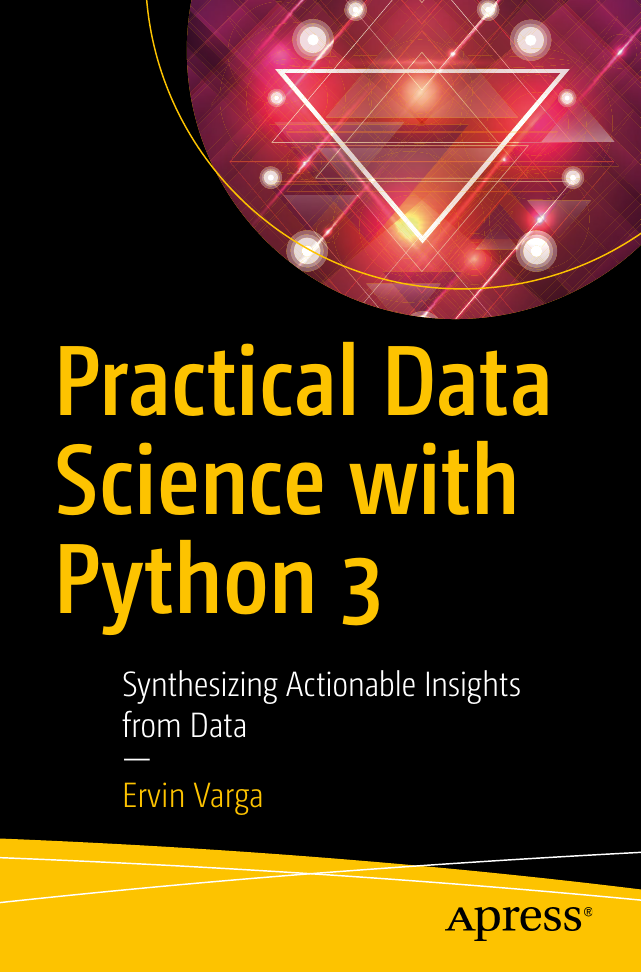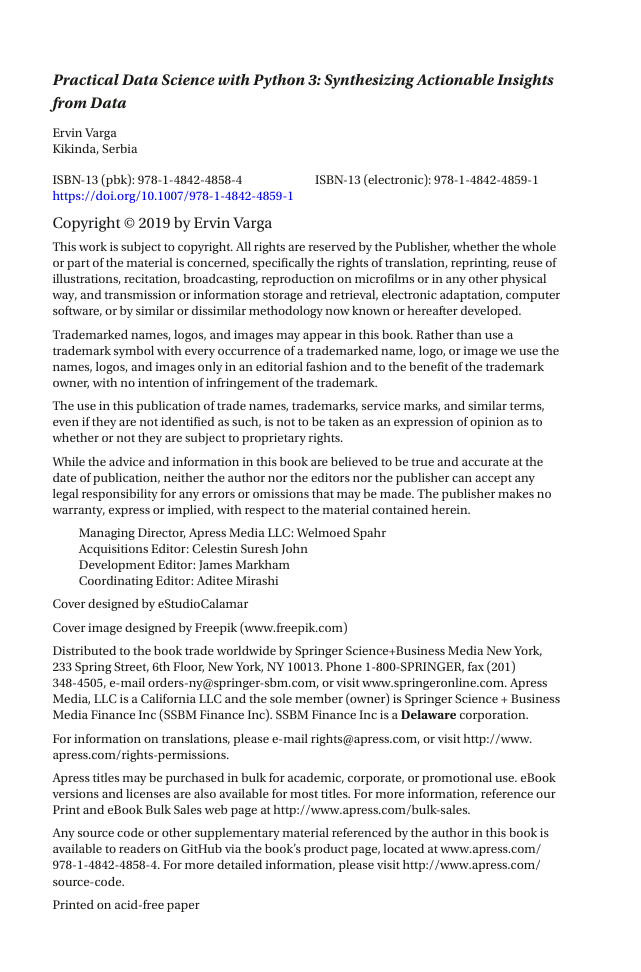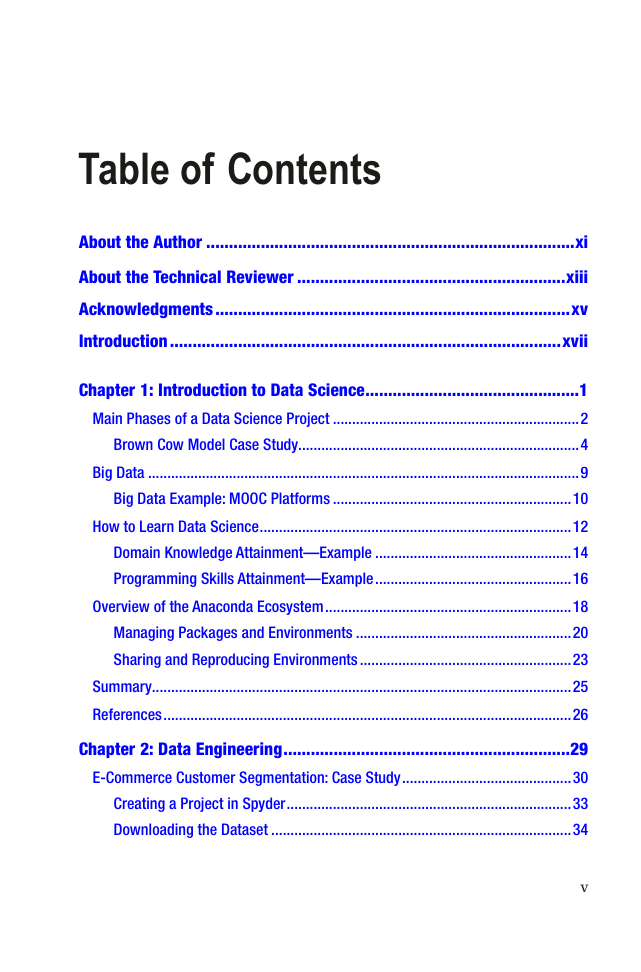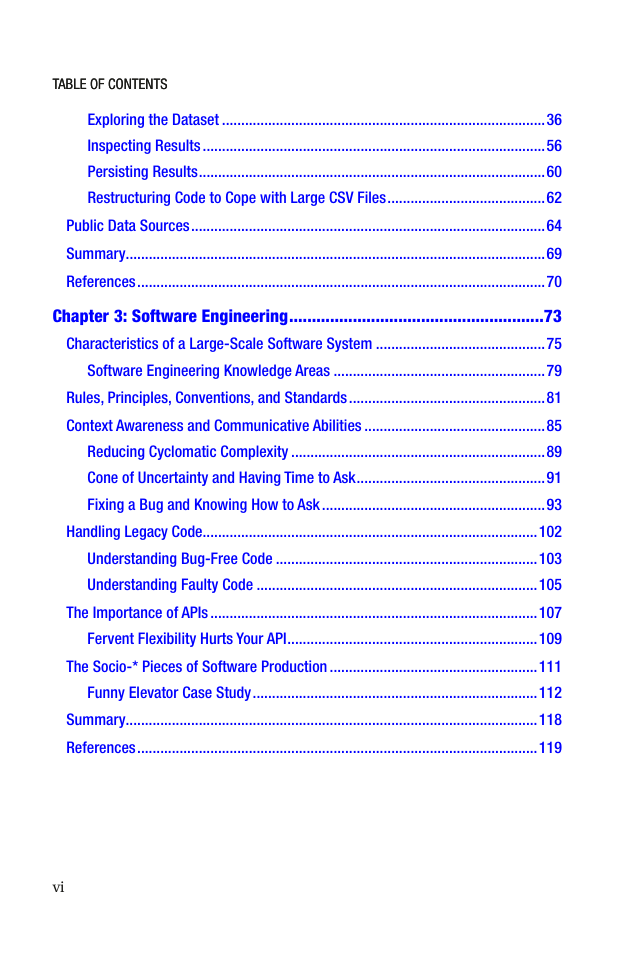Table of Contents
About the Author
About the Technical Reviewer
Acknowledgments
Introduction
Chapter 1: Introduction to Data Science
Main Phases of a Data Science Project
Brown Cow Model Case Study
Big Data
Big Data Example: MOOC Platforms
How to Learn Data Science
Domain Knowledge Attainment—Example
Programming Skills Attainment—Example
Overview of the Anaconda Ecosystem
Managing Packages and Environments
Sharing and Reproducing Environments
Summary
References
Chapter 2: Data Engineering
E-Commerce Customer Segmentation: Case Study
Creating a Project in Spyder
Downloading the Dataset
Exploring the Dataset
Finding Associations Between Features
Incorporating Custom Features
Automating the Steps
Inspecting Results
Persisting Results
Parquet Engines
Restructuring Code to Cope with Large CSV Files
Public Data Sources
Summary
References
Chapter 3: Software Engineering
Characteristics of a Large-Scale Software System
Software Engineering Knowledge Areas
Rules, Principles, Conventions, and Standards
Context Awareness and Communicative Abilities
Reducing Cyclomatic Complexity
Cone of Uncertainty and Having Time to Ask
Fixing a Bug and Knowing How to Ask
A Better Fix
Scenario 1: The Developer Doesn’t Speak the Language of Business
Scenario 2: The Developer Does Speak the Language of Business
A More Advanced Fix
Scenario 1: The Developer Doesn’t Speak the Language of Business
Scenario 2: The Developer Does Speak the Language of Business
Handling Legacy Code
Understanding Bug-Free Code
Understanding Faulty Code
The Importance of APIs
Fervent Flexibility Hurts Your API
The Socio-* Pieces of Software Production
Funny Elevator Case Study
First Optimization Attempt
Second Optimization Attempt
Teammate- and Business-Friendly Variant
Summary
References
Chapter 4: Documenting Your Work
JupyterLab in Action
Experimenting with Code Execution
Managing the Kernel
Connecting to a Notebook’s Kernel
Descending Ball Project
Problem Specification
Model Definition
Path Finder’s Implementation
Interaction with the Simulator
Test Automation
Refactoring the Simulator’s Notebook
Document Structure
Wikipedia Edits Project
Abstract
Motivation
Drawbacks
Conclusion
Summary
References
Chapter 5: Data Processing
Augmented Descending Ball Project
Version 1.1
Boundaries and Movement
Path Finding Engine
Retrospective of Version 1.1
Version 1.2
Enhancing the Input Subsystem
Enhancing the Output Subsystem
Retrospective of Version 1.2
Version 1.3
Establishing the Baseline
Performance Optimization
Retrospective of Version 1.3
Abstractions vs. Latent Features
Compressing the Ratings Matrix
Summary
References
Chapter 6: Data Visualization
Visualizing Temperature Data Case Study
Showing Stations on a Map
Plotting Temperatures
Closest Pair Case Study
Version 1.0
Version 2.0
Analysis of the Running Time
Version 3.0
Enquiry of Algorithms Evolution
Interactive Information Radiators
The Power of Domain-Specific Languages
Summary
References
Chapter 7: Machine Learning
Exposition of Core Concepts and Techniques
Overfitting
Underfitting and Feature Interaction
Collinearity
Residuals Plot
Regularization
Predicting Financial Movements Case Study
Data Retrieval
Data Preprocessing
Discovering Trends in Time Series
Transforming Features
Streaming Amounts
Feature Engineering
Implementing Streaming Linear Regression
Summary
References
Chapter 8: Recommender Systems
Introduction to Recommender Systems
Simple Movie Recommender Case Study
Introduction to LensKit for Python
Summary
References
Chapter 9: Data Security
Checking for Compromise
Introduction to the GDPR
Machine Learning and Security
Membership Inference Attack
Shadow Training
Poisoning Attack
Summary
References
Chapter 10: Graph Analysis
Usage Matrix As a Graph Problem
Opposite Quality Attributes
Partitioning the Model into a Bipartite Graph
Scalable Graph Loading
Social Networks
Summary
References
Chapter 11: Complexity and Heuristics
From Simple to Complicated
Counting the Occurrences of a Digit
Estimating the Edge Betweenness Centrality
The Count of Divisible Numbers
From Disorder to Complex
Exploring the KDD Cup 1999 Data
Cynefin and Data Science
Summary
References
Chapter 12: Deep Learning
Intelligent Machines
Intelligence As Mastery of Symbols
Manual Feature Engineering
Modeling the Aggregated State
Tying All Pieces Together
Machine-Based Feature Engineering
Implementation from Scratch
Implementation with PyTorch
Summary
References
Index
















 2023年江西萍乡中考道德与法治真题及答案.doc
2023年江西萍乡中考道德与法治真题及答案.doc 2012年重庆南川中考生物真题及答案.doc
2012年重庆南川中考生物真题及答案.doc 2013年江西师范大学地理学综合及文艺理论基础考研真题.doc
2013年江西师范大学地理学综合及文艺理论基础考研真题.doc 2020年四川甘孜小升初语文真题及答案I卷.doc
2020年四川甘孜小升初语文真题及答案I卷.doc 2020年注册岩土工程师专业基础考试真题及答案.doc
2020年注册岩土工程师专业基础考试真题及答案.doc 2023-2024学年福建省厦门市九年级上学期数学月考试题及答案.doc
2023-2024学年福建省厦门市九年级上学期数学月考试题及答案.doc 2021-2022学年辽宁省沈阳市大东区九年级上学期语文期末试题及答案.doc
2021-2022学年辽宁省沈阳市大东区九年级上学期语文期末试题及答案.doc 2022-2023学年北京东城区初三第一学期物理期末试卷及答案.doc
2022-2023学年北京东城区初三第一学期物理期末试卷及答案.doc 2018上半年江西教师资格初中地理学科知识与教学能力真题及答案.doc
2018上半年江西教师资格初中地理学科知识与教学能力真题及答案.doc 2012年河北国家公务员申论考试真题及答案-省级.doc
2012年河北国家公务员申论考试真题及答案-省级.doc 2020-2021学年江苏省扬州市江都区邵樊片九年级上学期数学第一次质量检测试题及答案.doc
2020-2021学年江苏省扬州市江都区邵樊片九年级上学期数学第一次质量检测试题及答案.doc 2022下半年黑龙江教师资格证中学综合素质真题及答案.doc
2022下半年黑龙江教师资格证中学综合素质真题及答案.doc